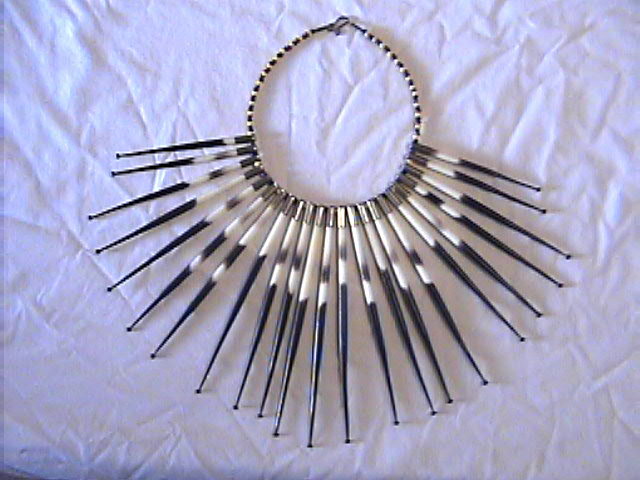(Fr-porc-épic piquants; Ger-Stachelschweinstachel; Nor-pinnnsvinets pigger; Rus-дикобраз [= porcupine only])
A. Porcupine quills. "Snowy Owl Sheath"
(height ~18.7 cm): Designed and made by Jessee J. Smith,
this panel of porcupine quills on braintan uses the naturally dark tips
of the quills to form the dark spots of the owl's feathers. (© photo by Jessee J. Smith, from http://students.mjs.edu/smithJessee/art170/BQ3.html )
B. Porcupine quills. Left,
North American porcupine (Erethizon dorsatum (Linnaeus, 1758)) quills (length of
longest quill - 5.7 cm) from a medium-sized road-killed porcupine found
near Grassy Butte, North Dakota; "these are representative of the sizes
I usually favor for quilling." (Jessee Smith, personal
communication, 2006). (© photo by Jessee J. Smith, from http://students.mjs.edu/smithJessee/art170/BQ3.html). Right, North
African crested porcupine
(Hystrix
cristata Linnaeus,
1758)
quills
(length - 40 - 45 cm)
from Hatch Farms, Spokane, Washington. (© photo by Griffin Hatch, from www.hatchfarms.cwhatch.com).
DESCRIPTION: Phylum,
Chordata; subphylum,
Vertebrata; class,
Mammalia; order, Rodentia;
suborder, Hystricognathi; family, Erethizontidae: Porcupine quills,
which are "modified guard hairs" (Roze, 1989),
consist largely of keratin fibers. At least two rather different
kinds of quills have been fashioned into jewelry and/or decorative
items: Those from the North
American porcupine (Erethizon dorsatum (Linnaeus, 1758)) and those from the North African
crested porcupine (Hystrix
cristata
Linnaeus, 1758).
On the following list, the geographic source is listed for properties
that differ in any appreciable way.
Colors - Of the quills usually used, those of the North American porcupines are white with brownish or dark gray tips whereas those from African are white, off-white or cream colored with dark brown, dark gray to black bands -- some have as many as 25 bands -- see Figure B. An albino North African crested porcupine on the Hatch farms, Spokane, Washington yields pure white quills (Jeff Hatch, personal communication, 2006).
Colors - Of the quills usually used, those of the North American porcupines are white with brownish or dark gray tips whereas those from African are white, off-white or cream colored with dark brown, dark gray to black bands -- some have as many as 25 bands -- see Figure B. An albino North African crested porcupine on the Hatch farms, Spokane, Washington yields pure white quills (Jeff Hatch, personal communication, 2006).
